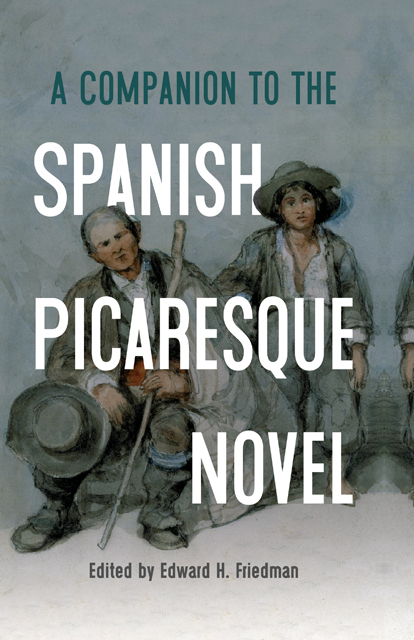Book contents
- Frontmatter
- Contents
- List of Illustrations
- List of Contributors
- Foreword
- 1 The Picaresque as a Genre
- 2 On the Picaresque and Its Origins
- 3 Francisco Delicado, La lozana andaluza
- 4 Lazarillo de Tormes
- 5 Mateo Alemán, Guzmán de Alfarache
- 6 Francisco de Quevedo, La vida del Buscón
- 7 La pícara Justina
- 8 Alonso Jerónimo de Salas Barbadillo, La hija de Celestina
- 9 Miguel de Cervantes and the Picaresque
- 10 Vicente Espinel, Marcos de Obregón
- 11 Carlos García, La desordenada codicia de los bienes agenos
- 12 Estebanillo González
- 13 Critical Approaches to the Picaresque
- 14 The Picaresque in Spanish America
- 15 Continuations: France and England
- 16 The Continuity of the Picaresque: Spain
- Bibliography
- Index
- Tamesis • Companions
1 - The Picaresque as a Genre
Published online by Cambridge University Press: 11 January 2023
- Frontmatter
- Contents
- List of Illustrations
- List of Contributors
- Foreword
- 1 The Picaresque as a Genre
- 2 On the Picaresque and Its Origins
- 3 Francisco Delicado, La lozana andaluza
- 4 Lazarillo de Tormes
- 5 Mateo Alemán, Guzmán de Alfarache
- 6 Francisco de Quevedo, La vida del Buscón
- 7 La pícara Justina
- 8 Alonso Jerónimo de Salas Barbadillo, La hija de Celestina
- 9 Miguel de Cervantes and the Picaresque
- 10 Vicente Espinel, Marcos de Obregón
- 11 Carlos García, La desordenada codicia de los bienes agenos
- 12 Estebanillo González
- 13 Critical Approaches to the Picaresque
- 14 The Picaresque in Spanish America
- 15 Continuations: France and England
- 16 The Continuity of the Picaresque: Spain
- Bibliography
- Index
- Tamesis • Companions
Summary
Picaresque narrative begins as an ingenious response to previous writings. In sixteenth-century Spain, the dominant forms of fiction were idealistic in nature: sentimental, pastoral, and chivalric romance. Sentimental romance brings in the courtly love tradition in works such as Diego de San Pedro’s Cárcel de amor (The Prison of Love, 1492), which represents amorous pursuit as an emotional and verbal battle. Pastoral romance, as in Jorge de Montemayor’s Los siete libros de la Diana (The Seven Books of Diana, 1559), offers an embellished vision of bucolic life, with eloquent shepherds and shepherdesses in glorified settings far removed from rustic customs. Chivalric romance, exemplified by Garci Rodríguez de Montalvo’s Amadís de Gaula (Amadis of Gaul, 1508), exalts the valor, heroic exploits, and service to designated ladies of illustrious knights-errant. Stemming from classical antiquity, romance replaces quotidian reality and its imperfections with positive and rose-colored visions and with exaggerated and stylized plots. Subsequently, there is a rising interest in the development of literary realism as an alternative mode of composition. The Italian novella, including Giovanni Boccaccio’s Decameron (1353), and other European texts herald a shift from idealism to realism. Francisco Delicado’s narrative in dialogue form, La lozana andaluza (The Lusty Andalusian Woman, 1528), is a notable Spanish precursor to this trend. The picaresque genre signals the movement toward alternative ways of constructing and narrating fiction. This was a moment of creation and of experimentation, and incipient realism became linked with satire and parody and with deviation from existing paradigms.
A minimum of two works technically can constitute a genre. The anonymous Lazarillo de Tormes (1554) imitates and deflates the idealism of the romances of chivalry and of autobiography by having a character from the lowest rungs of society narrate his story. His genealogy is the antithesis of lofty bloodlines, and his progression through an assortment of trials and tribulations is hardly worthy of encomiums. The narrator/protagonist seeks upward mobility in a rigidly hierarchical society. Lázaro’s aspirations are undermined by social protocol and by an author who accentuates the irony of the ambitions and of the discourse. Mateo Alemán follows with Guzmán de Alfarache, published in two parts (1599, 1604), considerably longer, but sharing a first-person narrator, lowly lineage, a series of masters, impractical objectives, and humiliating incidents.
- Type
- Chapter
- Information
- A Companion to the Spanish Picaresque Novel , pp. 1 - 6Publisher: Boydell & BrewerPrint publication year: 2022



